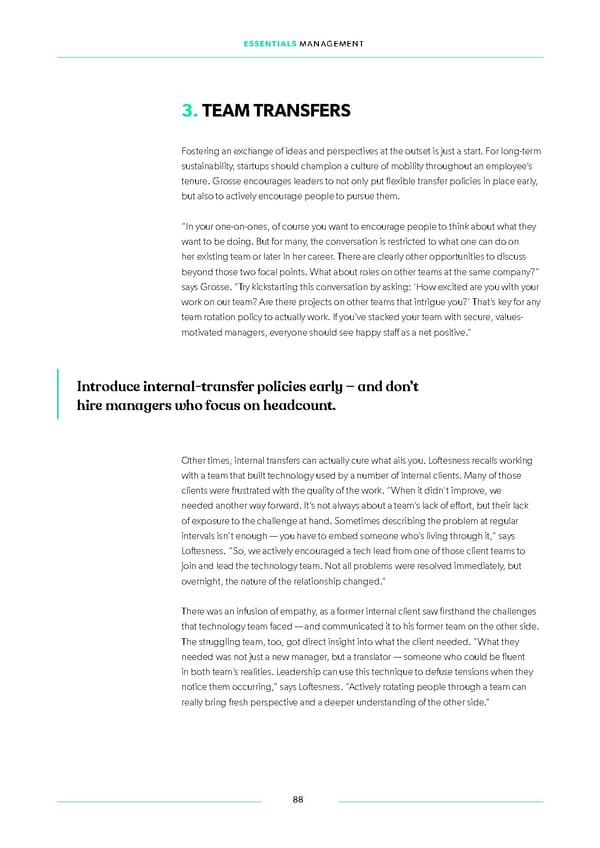ESSENTIALS MANAGEMENT 3. TEAM TRANSFERS Fostering an exchange of ideas and perspectives at the outset is just a start. For long-term sustainability, startups should champion a culture of mobility throughout an employee’s tenure. Grosse encourages leaders to not only put lfexible transfer policies in place early, but also to actively encourage people to pursue them. “In your one-on-ones, of course you want to encourage people to think about what they want to be doing. But for many, the conversation is restricted to what one can do on her existing team or later in her career. There are clearly other opportunities to discuss beyond those two focal points. What about roles on other teams at the same company?” says Grosse. “Try kickstarting this conversation by asking: ‘How excited are you with your work on our team? Are there projects on other teams that intrigue you?’ That’s key for any team rotation policy to actually work. If you’ve stacked your team with secure, values- motivated managers, everyone should see happy staff as a net positive.” Introduce internal-transfer policies early — and don’t hire managers who focus on headcount. Other times, internal transfers can actually cure what ails you. Lotfesness recalls working with a team that built technology used by a number of internal clients. Many of those clients were frustrated with the quality of the work. “When it didn’t improve, we needed another way forward. It’s not always about a team’s lack of effort, but their lack of exposure to the challenge at hand. Sometimes describing the problem at regular intervals isn’t enough — you have to embed someone who’s living through it,” says Lotfesness. “So, we actively encouraged a tech lead from one of those client teams to join and lead the technology team. Not all problems were resolved immediately, but overnight, the nature of the relationship changed.” There was an infusion of empathy, as a former internal client saw ifrsthand the challenges that technology team faced — and communicated it to his former team on the other side. The struggling team, too, got direct insight into what the client needed. “What they needed was not just a new manager, but a translator — someone who could be lfuent in both team’s realities. Leadership can use this technique to defuse tensions when they notice them occurring,” says Lotfesness. “Actively rotating people through a team can really bring fresh perspective and a deeper understanding of the other side.” 88
 Essentials Management First Round Capital Page 87 Page 89
Essentials Management First Round Capital Page 87 Page 89